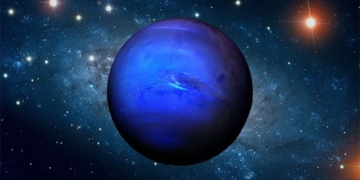Following the mysterious black supermoon is a strange snow moon, seemingly slipping out of Earth’s reach.
According to Live Science, when the full moon occurs on February 5 or 6 (depending on the time zone), the moon will appear significantly smaller or more distant than usual.
The reason is that after the extremely close approach to Earth during the new moon phase – the phenomenon known as “super new moon” on the first day of the Lunar New Year, the moon gradually moves to its farthest point from the planet in its orbit.
At this far point, it becomes a full moon.

A “snow moon” scene – (Photo: DATE AND TIME).
According to calculations by Earth Sky, the full moon in February, often referred to as the “snow moon” by Europeans and Americans due to its timing during heavy snowfall, will reach its peak fullness at 1:28 AM on February 6 (Vietnam time), appearing between the constellation Leo and the brightest star, Regulus, in that constellation.
During its full phase, this year’s snow moon will be as far from Earth as 405,830 km, significantly more than the average distance of 384,400 km. This distance places it in a state opposite to “supermoon,” known as “micromoon.”
Additionally, sky enthusiasts in February will witness a “dance” of two of the brightest planets in the night sky, Venus and Mars. They will move increasingly closer together, one shining with a bright, pale yellow light and the other a mysterious red hue.
The best nights to observe these planets will be the nights of February 20 and 21, as the new moon will be positioned in complete darkness at 2:06 PM on February 21 Vietnam time. Evenings free from the moon’s interference will allow for stunning observations of other phenomena, such as planetary dances and meteor showers.




















































